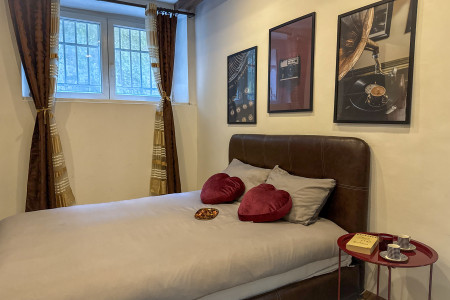| +381112620685 |
| office@beogradskatvrdjava.co.rs |
| http://kulanebojsa.rs/ |
| Belgrade , Bulevar Vojvode Bojovića |

Belgrade Attractions - Nebojsa Tower from the list Belgrade Attractions is located at the Lower Town of Belgrade Fortress, at the entrance of the former Dunav port and one of the most famous towers. During the Ottoman rule in it the Greek revolutionary Riga Fere was executed. The name comes from the negation of the verb to be afraid. With this name it has become a tower that is not afraid of any opponent or attack, it has become impregnable. Often people mistakenly call it Nebojsa’s tower, however this is incorrect and has a completely different meaning.
At the time of Despot Stefan Nebojsa Tower was a Donjon tower of Belgrade fortress, and it is theorised that it looked like the Despot Tower of the Manasija monastery.
There is a legend that the tower as impregnable, after the Turks conquered Belgrade Fortress, soared into the air and flew down to the Lower city in order to remain out of their reach and stay unconquered. There is no evidence to prove it has been conquered and historically Nebojsa Tower has never been under Turkish rule.
This is why Nebojsa Tower is a witness and testimony of invincibility and disobedience to the turkish reign.
First names of Nebojsa Tower were White and Timisoara tower, and its present name was given in the 17th century. The original Nebojsa Tower was destroyed along with a small town in a gunpowder explosion, and the name Nebojsa was given to the tower on the dock.
Octagonal in shape with thick walls, located on four floors and a ground floor with a total height of 22m. On all sides and all floors there are openings for cannons used by the crew to defend the Belgrade fortress from invaders from all directions. At first, the top of the tower was flat with a battlement and forward wooden consoles for attacking the enemy. During the reconstruction of the Belgrade fortress by the Austrians in the 18th century, the top of the tower was replaced by a roof structure that still exists today.
Nebojsa Tower was built by Hungarians in 1460, in order to protect the approach to the Danube quay and the only port from the Turks. During the conquest of Belgrade in 1521 the Turks have penetrated the Lower city after they had managed to conquer the tower Nebojsa by demolishing it with heavy artillery attacks.
The Nebojsa Tower has great historical significance in the turbulent history of Belgrade and together with the tower Mlinarica it is the strongest cannon tower in the Lower Town. For this reason, it was demolished many times and rebuilt because of frequent attacks as it was the strongest link of the Belgrade fortress.
After losing the Danube port, the Turks turned Nebojsa Tower into the most famous prison of the Belgrade fortress, and because of this role it remains one of the dark symbols of Belgrade. Riga Fera, a Greek revolutionary was its most famous prisoner, where he was executed on 24th of June in 1798. Metropolitan Metodije also left his life there in 1800 by the order of Hadzi Mustafa Pasha.
The area around the tower is a mass grave of the concentration camp Jasenovac, because during the Second World War, that is where they buried bodies that were swarming the river Sava. The fishermen buried the mutilated corpses next to the tower.
Today, the tower has five exhibition areas, Annex, which deals with the history of the tower as a military facility, Nebojsa Tower as a prison, Riga Fera life and work, the first Serbian uprising and Belgrade in the first half of the 19th century.
| day | From | To |
|---|---|---|
| Monday | 11:00 | 19:00 |
| Tuesday | 11:00 | 19:00 |
| Wednesday | 11:00 | 19:00 |
| Thursday | 11:00 | 19:00 |
| Friday | 11:00 | 19:00 |
| Saturday | 11:00 | 19:00 |
| Sunday | 11:00 | 19:00 |






